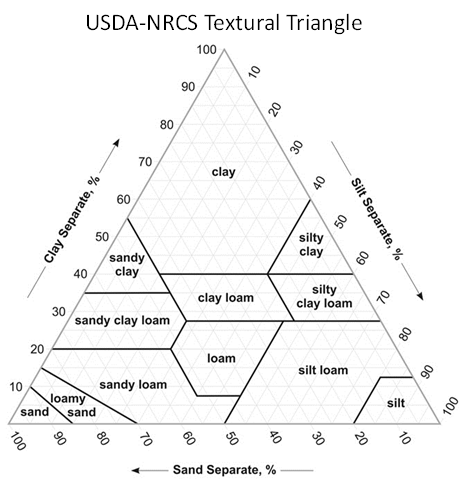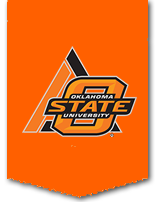What System to Install
The decisions relating to the type of septic system permitted for installation in an area depend on one or both of the following information: 1) observed soil profile properties and 2) an estimate of the degree of water flow through the soil profile. Septic system installation in Oklahoma is regulated by Department of Environmental Quality (DEQ) and the type of septic system permitted is largely based on observed soil properties –mainly soil texture of the porous material as well as soil color and the presence of restricting layers.
Soil Texture and Water Flow
Soil texture is the relative proportions of the inorganic soil separates: sand, silt and clay. It is practically viewed as a physical parameter that indicates the relative coarseness or fineness of a soil material. To aid in land use decisions, the USDA-NRCS came up with a textural triangle to classify soils into twelve textural classes. Soils in a class, which may have different sand, silt and clay contents, are expected to have similar properties and hence could be managed or utilized in the same manner.
 Soil texture affects the size distribution and the connectivity of the pores in a soil body. Fine-textured soils (clay, silty clay, sandy clay) would tend to have greater proportion of smaller-sized pores that are likely less-connected and more tortuous causing ineffective water flow. Coarse-textured soils (coarse sand, loamy coarse sand, soils with > 35% rock fragments by volume) tend to have large pores that are well-connected allowing very effective water flow.
Soil texture affects the size distribution and the connectivity of the pores in a soil body. Fine-textured soils (clay, silty clay, sandy clay) would tend to have greater proportion of smaller-sized pores that are likely less-connected and more tortuous causing ineffective water flow. Coarse-textured soils (coarse sand, loamy coarse sand, soils with > 35% rock fragments by volume) tend to have large pores that are well-connected allowing very effective water flow.
Both fine- and coarse-textured soils are undesirable media for treating onsite septic wastewater. Fine-textured soils may cause wastewater to pond over a subsurface application location that could eventually break through the soil surface (“surfacing”). Conversely, coarse-textured soils allow wastewater to percolate through the soil profile rather quickly and could recharge the groundwater without effective treatment. Non-conventional or more advanced systems will be required for areas having these soils to be permitted for septic wastewater application.
Other soils (medium-textured and some coarse-textured soils) that allow effective enough water flow to prevent surfacing, but at a rate slow enough to prolong the residence time of the wastewater in the soil allowing effective treatment, are generally permitted for installation of most septic systems permissible in Oklahoma.
In Oklahoma, the different USDA-NRCS textural classes are further re-categorized into Soil Groups that serve as primary basis in decisions related to onsite septic systems (Table 1). Soils that are categorized into these different groups are those in the Vertical Separation. The Vertical Separation refers to the soil that vertically separates the trench bottom of the septic system and a limiting layer (e.g. rock layer) or the seasonal high water table (as indicated by the presence of redoximorphic features; see discussion below about redoximorphic features).
Table 1. Soil Groups used as basis in septic system decisions in Oklahoma. Source: DEQ, 2012.
Soil Red Flags: Restricting Layers and Redoximorphic Features In many cases, particulars about the design of septic system components are determined by the presence and the depth of observation of certain soil characteristics. These include the presence of a restricting layer or of redoximorphic features.
Restricting layers are those that are impervious to boring by hand auger or layers that may limit water movement through the ground (Carter, 2008). In Oklahoma, the most common restricting layers are Lithic or Paralithic materials – rocks and fractured rocks not considered as soil that are made up of sandstone or shale (Fig. A). These layers are designated as R or Cr in soil profile descriptions.
Redoximorphic features are soil morphological elements that develop when a particular section in the soil had been saturated (i.e. under the water table) for durations long enough to cause anaerobic conditions which promote iron reduction. Particular attention is given to features called Redox Depletions – sections in the soil profile having Munsell® colors of chroma < 2 and value > to 4 or having colors in the Gley page of a Munsell® color book (Fig. B).
Criteria used in Septic System Decisions in Oklahoma
Table 2. System options with minimum vertical separation requirements. Source: DEQ, 2012.
Alternative Systems
As indicated in Table 2, the design and installation of an on-site septic system is dependent on many factors. Apart from the soil properties, site properties such as lot size and size of residence, among others, are considered in the design. There are instances when a system described in Table 2 cannot be designed and an alternative on-site system is needed. Over the last decade, between 1-4% of new systems installed in Oklahoma each year are alternative systems (Fig. 1). These systems must be approved by the DEQ prior to installation. For additional information concerning the types of alternative systems available and the application/approval process for alternative systems, please contact your local DEQ office or call 405-702-6100.


